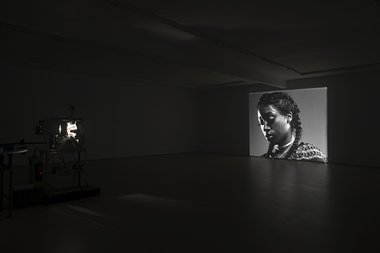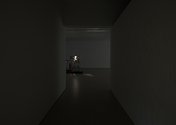John Hurrell – 27 September, 2017
It might be argued that by making a sequence of works like this one and the works in 'Shout Whisper Wail!', Thompson is conflating racially-motivated murder with bumbling manslaughter, for the three cases of police-caused deaths seem very different. However, on the evidence of the films of Castile's death, the American court's rejection of manslaughter is alarming, especially if it is true that the victim's gun was found after his death to be still in his back pocket.
With related work currently on display in Nastasha Conland’s Shout Whisper Wail! at AAG, and this project recently presented in Chisenhale Gallery in East London (where Luke Willis Thompson had a residency), autoportrait is based on an incident last year in Minnesota in when a black driver (Philando Castile) was pulled over by a Latino policeman (Jeromino Yanez) for a traffic violation and shot dead, his death recorded by his girlfriend (Diamond Reynolds) with her cell phone and placed on Facebook Live. She was in the car with her daughter, and is the subject of Thompson’s 35 mm film, a 9 minute silent loop shown (noisily) via a projector.
This bafflingly preventable incident and its legal consequences has had a lot of media coverage, especially as there was a trial where Yanez was acquitted of manslaughter charges, and subsequent public protests. (There was also another trial, of Reynolds, relating to another incident.) Reynolds’ video of the shooting tragedy and another video taken by another policeman are both widely available online.
Thompson’s filmed b/w portrait of Reynolds is made in three-quarter angle and in two parts. One—showing her more distant from the camera—presents her dressed in a patterned dark blouse, with plaited pigtails, false eyelashes and praying or talking to herself in an agitated fashion. The other—where she is closer to the camera—shows her wearing a voluminous white blouse and large aviator glasses. She is not speaking and comparatively calm.
Both portraits, although ostensibly about an appalling tragedy caused at the very least by police stupidity, have a glamorous allure, especially compared to say the work in Shout Whisper Wail! which is more subtly confrontational (the sitters are more frontally positioned) and less tonally extended. The autoportrait images are a vivid contrast to the news media coloured images of Reynolds in a distraught state being interviewed in relation to this and the other later court case. They could be from a fashion shoot.
Thompson’s presentation is in the large gallery which you enter via a fabric-walled corridor that shuts off the second, much smaller gallery. The whirring sound of the film projector is dominant and one is struck by the beauty of the b/w 35 mm film with its fastidious lighting, deep resonant dark tones and piercing whites. It is clear that Thompson here is serving as an advocate (or spin doctor) for the controversial Reynolds. He is making her look like a model, and providing a political tool to counter mainstream American media and the claims of the police.
It might be argued that by making a sequence of works like this one and the works in Shout Whisper Wail!, Thompson is conflating racially-motivated murder with bumbling manslaughter, for the three cases of police-caused deaths seem very different. However, on the evidence of the films of Castile’s death, the American court’s rejection of manslaughter is highly alarming, especially if it is true that the victim’s gun was found after his death to be still in his back pocket.
In some ways this film is an interesting foil to Thompson’s untitled installation with the three roller doors, exhibited in Te Tuhi (with a judge’s commentary on court proceedings) in 2012. That work is the best work of Thompson’s career so far, in my opinion. Autoportrait, in comparison, has no textual component and seems conceptually slightly stunted, through parallels can be found if you dig around online and investigate the back story—independentally of attending to the gorgeously shot film. Worth doing.
John Hurrell
Recent Comments
John Hurrell
Winning this, and being in the Turner prize line-up is quite something. https://www.nzherald.co.nz/nz/news/article.cfm?c_id=1&objectid=12053960


 Two Rooms presents a program of residencies and projects
Two Rooms presents a program of residencies and projects Advertising in this column
Advertising in this column



This Discussion has 1 comment.
Comment
John Hurrell, 10:35 a.m. 18 May, 2018 #
Winning this, and being in the Turner prize line-up is quite something.
https://www.nzherald.co.nz/nz/news/article.cfm?c_id=1&objectid=12053960
Participate
Register to Participate.
Sign in
Sign in to an existing account.